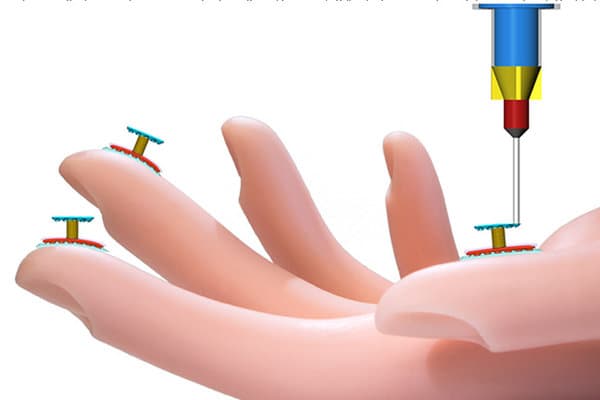Minnesota researchers devise 3D printed bionic skin equipped with the sensation of touch
The various characteristics of life along with the crucial deciding factor, reproduction has now started to sublimate as the never ending progress of technology is keen to impart life into the next generation robots. A team of engineering researchers at the University of Minnesota has come up with a game-changing technology concerning the 3D printing stretchable electronic sensory devices which may be the cause for the man-made instruments to feel the environment surrounding them. In short, "touch" will not be limited to the capabilities of the living beings only. On the flip side, the research takes a giant leap forward in printing stretchable electronic circuits on real skin.
The research leader Michael McAlpine, a University of Minnesota mechanical engineering associate professor has expressed that the technology can have innumerable applications in practice. Currently, in minimally invasive surgeries, surgeons operate a particular area by using camera generated images. However, if the bionic skin is equipped with the latest technology is placed upon the surgical robots, the surgeons will not only "see" the area but "feel" it. As suggested by the internationally acclaimed "bionic ear" maker McAlpine, this has its significant utilization in the wearable technology. In future, it can be used for health monitoring or by soldiers to detect dangerous chemicals on site, taking into consideration that the technology is friendly to the human skin.

One of a kind 3D printer, printing touch sensors directly on model hand
Similar to the cyborgs seen in sci-fi films, the skin doped with a 3D printed stretchable electronic circuit has the capability to even detect your pulse in real time. As suggested by McAlpine, although the technology is yet to take its chance on human skin, but it is already tested on a curved surface of a model hand. With his team, McAlpine devised a unique sensing fabric maneuvered using a customized 3D-printer created in their laboratory. Being a multifunctional printer, it features four nozzles to print the various specialized "inks" that develops the layers of the electronic device.
The layers include a silicone base layer, conducting ink generated top and bottom layers, a coil-shaped pressure sensor, and a sacrificial layer used to hold the top layer and later washed away as it is done with its work. The inks used in this process are good to go in normal temperature. As per the published report, conventional 3D printing using plastics is not applicable for their research. The printed circuit is not only accurate in sensing but also is stretchable up to 3 times their original size.
Having a powerful multifunctional 3D printing device, capable of weaving flexible electronics opens the door to the highly skilled development improving in the areas of health monitoring, energy harvesting, chemical sensing and much more. According to the researchers, the best part of this innovation was to discover the manufacturing alongside the research objective. According to the same report, the research team is now planning to delve into the semiconductor inks and its usage on human bodies. The complete research has been published in the Advanced Materials journals.
Watch the sensor getting printed on model hand:
Source: <a href="https://twin-cities.umn.edu/news-events/3d-printed-bionic-skin-could-give-robots-sense-touch" target="_blank" rel="nofollow noopener noreferrer">twin-cities.umn.edu</a>
The research leader Michael McAlpine, a University of Minnesota mechanical engineering associate professor has expressed that the technology can have innumerable applications in practice. Currently, in minimally invasive surgeries, surgeons operate a particular area by using camera generated images. However, if the bionic skin is equipped with the latest technology is placed upon the surgical robots, the surgeons will not only "see" the area but "feel" it. As suggested by the internationally acclaimed "bionic ear" maker McAlpine, this has its significant utilization in the wearable technology. In future, it can be used for health monitoring or by soldiers to detect dangerous chemicals on site, taking into consideration that the technology is friendly to the human skin.

One of a kind 3D printer, printing touch sensors directly on model hand
The layers include a silicone base layer, conducting ink generated top and bottom layers, a coil-shaped pressure sensor, and a sacrificial layer used to hold the top layer and later washed away as it is done with its work. The inks used in this process are good to go in normal temperature. As per the published report, conventional 3D printing using plastics is not applicable for their research. The printed circuit is not only accurate in sensing but also is stretchable up to 3 times their original size.
Having a powerful multifunctional 3D printing device, capable of weaving flexible electronics opens the door to the highly skilled development improving in the areas of health monitoring, energy harvesting, chemical sensing and much more. According to the researchers, the best part of this innovation was to discover the manufacturing alongside the research objective. According to the same report, the research team is now planning to delve into the semiconductor inks and its usage on human bodies. The complete research has been published in the Advanced Materials journals.
Watch the sensor getting printed on model hand:
Source: <a href="https://twin-cities.umn.edu/news-events/3d-printed-bionic-skin-could-give-robots-sense-touch" target="_blank" rel="nofollow noopener noreferrer">twin-cities.umn.edu</a>
0
